Technology has revolutionized how we handle health care. The remarkable rise in technology usage has motivated the creation of online healthcare platforms. These platforms have made interactions between patients and healthcare professionals more efficient than ever.
In the past, managing health information and communication often meant having regular in-person meetings. But now, technology has made things much more flexible. Patients can conveniently keep track of their appointments, look at their test results, and get advice from health professionals online, all thanks to the power of the internet and web apps.
This article from Nexle Corporation dives deep into the world of healthcare web development, exploring everything from different design styles to major industry trends.
Use Cases for Developing Healthcare Web Portal Solutions
Patient Healthcare Predictive Analytics
In the realm of healthcare website development, the use of predictive analytics technology lets healthcare providers support doctors in forecasting potential outcomes. By harnessing data from systems such as the Tricare e-portal, healthcare experts can identify potential health issues and the warning signs of impending problems. Ensuring patient safety is paramount for effective treatment, making it imperative to prioritize safety in healthcare.
Technology companies utilize patient medical information to construct electronic platforms with AI and machine learning algorithms. These programs analyze data from healthcare web services through graphical representations, enabling users to identify patterns and trends. As a result, individuals gain insights and are better equipped to make informed decisions.
Predictive analysis in preventive health care can be carried out through various means. Sophisticated algorithms can ascertain a patient’s risks and present that crucial data on both patient and healthcare platforms. The decision-making process isn’t merely reliant on electronic health records (EHR); it also incorporates data from remote monitoring, a patient’s social profiles, customer behavior, and even their habits and lifestyle factors. This all-encompassing approach empowers providers with the right tools to make informed decisions in order to enhance their patient’s health.
In healthcare, predictive analysis utilizes data and technology to anticipate various aspects of care. By employing analytical methods, data mining, AI, and machine learning, predictive analysis can decipher medical data and provide accurate predictions about events, outcomes, and trends in the healthcare industry.
Read more: eCommerce App Development: Ultimate Guide and Use Cases
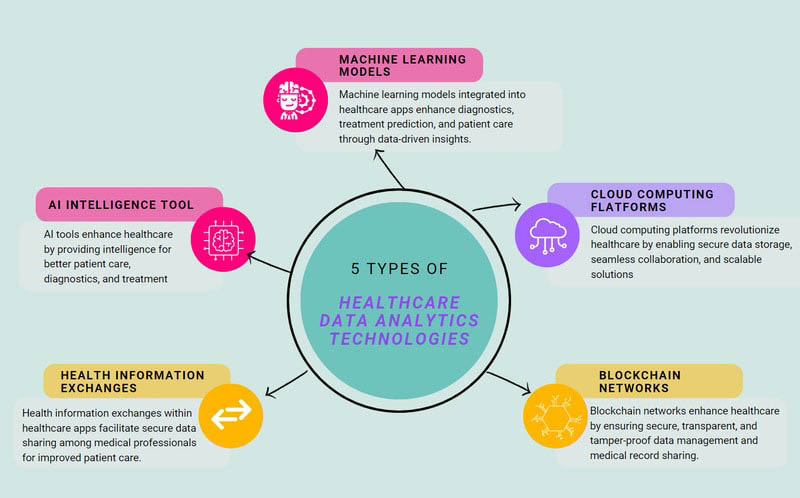
Remote Consultation
Web application development – Telemedicine has been popular for over a decade and is expected to keep growing.
Telemedicine is widely applied in many medical fields, such as teleradiology, telepathology (distant pathology), telepsychiatry (solution to distant mental illnesses), teledermatology (Solution to remote skin diseases), teleophthalmology (solving of remote eye disease), telenerphrology (resolution for remote kidney disease), telerehabilitation (resistant rehabilitation solution), telesurgery (remote surgery solution), telecardiology (release to cardiovascular diseases).
Doctors use basic remote consulting apps to advise their patients. They test patients with these applications, made by some of the best medical website designers and developers. Wearable devices, devices that work with the Internet of Things (IoT), and smart tools that record the patient’s heart rate, temperature, and other physiological signs can be used to keep track of their health. Web design for medical equipment can make connecting them to smart devices easier.
Read more: What Is the Difference Between Web App and Mobile App, and Which Is Better?

Remote consulting is possible with web application development
Online Pharmacies
Online pharmacy platforms in web applications provide numerous advantages compared to traditional pharmacy systems. The emergence of telemedicine has fueled the growth of online pharmacy sites. When a doctor electronically prescribes medication, the online pharmacy site swiftly sends it directly to the patient’s home. As a result, patients no longer have to visit physical stores, saving both time and money on transportation costs.
With the help of online virtual doctor software and online health information system technology, healthcare web development service providers can build online drugstore platforms that make sure drugs are safe and legal.
CAD Software For Dentists
Improvements made to CAD and CAM software in dentistry are part of healthcare web portal software development. Using CAD software in dental work is key to enhancing the process of creating dental products. This Computer-Aided Design software allows dentists to digitally design a variety of dental items such as veneers, dentures, implants, inlays, bridges, and many others in three dimensions.
Dental CAD technology allows dentists to create personalized products for their patients, tweaking the shape, size, and placement to precisely meet each individual’s needs. The digital models generated can then be utilized in creating guidelines for direct mapping or for guiding a CNC machine through the manufacturing process.
When dentistry integrates the use of CAD software, it dramatically enhances the speed, accuracy, and overall workflow. This elevated efficiency facilitates the creation of premium dental products that cater explicitly to the needs of the patients. Besides, dental offices can personalize CAD software to dovetail with their operations and boost both the design and manufacturing processes.
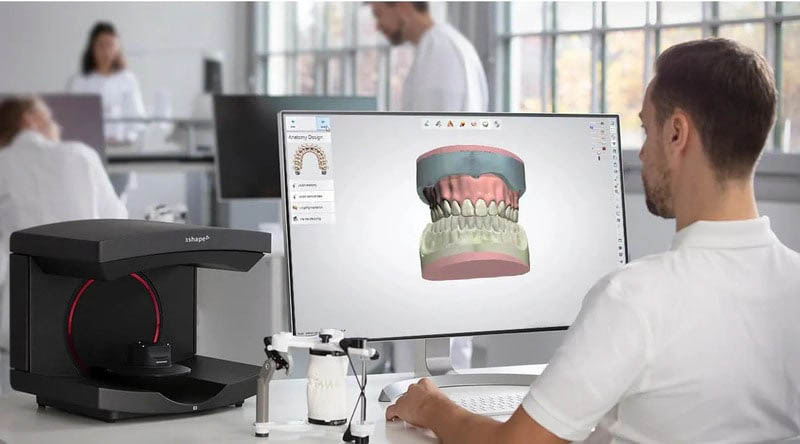
CAD Software For Dentists
Hospital Inventory Management
Healthcare organizations need to handle their medical supplies well for them to work well.
Designing a website for healthcare helps hospitals keep track of their medical materials so that they can be used to serve patients. This includes both high- and low-value items like pins and injector tubes, as well as expensive implants and surgery tools. These more expensive consumables make up a big part of the hospital’s budget, so keeping track of, handling, and paying for this medical inventory for good financial management is important.
Claims Processing and Verification
Medical web design and development automation helps providers with medical claims management filing, follow-up, medical online EMR, and processing. Payers need claims processing and verification solutions. Providers and payers have to communicate frequently about claims processing. Incomplete claims, lacking information, and missing documentation might cause problems.
Top medical website design firms automate these issues. Pre-filling and pre-population using past-case analysis and confirmed data helps reduce anomalies. This strategy in creating a medical website and health insurance web portal reduces processing risks, claims rejections, and payer verification.
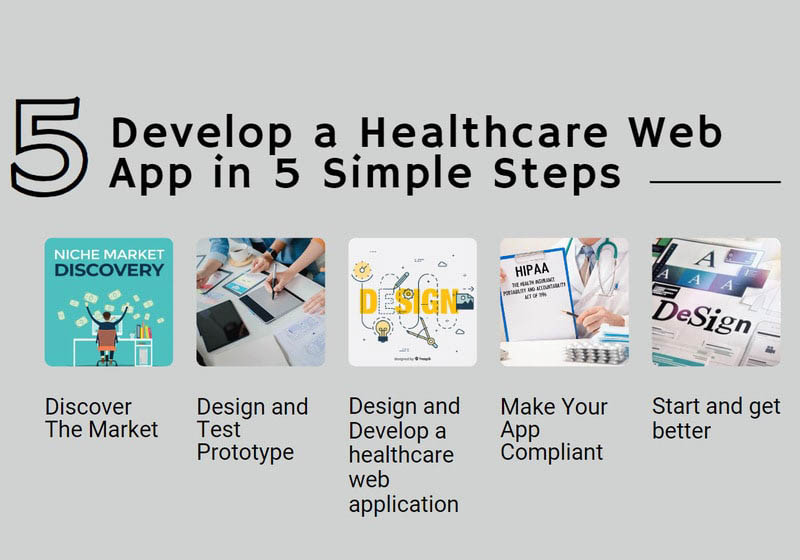
Develop a healthcare web app in 5 simple steps
How to Develop A Healthcare Web App? 5 Step-by-step Guide
To ensure a healthcare web development succeeds, several steps must be taken. Here’s a step-by-step plan to help you get through the process:
Step 1: Discover The Market
Begin by diving deep into the healthcare market. Look for patterns, what potential users need, and who your likely competition might be. Identify which problems your web app will address and decide who your intended users are. Equipped with this understanding, you can craft a comprehensive plan for bringing your app to life.
Step 2: Design and Test Prototype
Make a prototype of your healthcare website’s user interface and experience. Utilize techniques like wireframes and product mockups to assist with this task. You should then test this prototype extensively, collecting and considering feedback from potential users. Fine-tune your product based on this feedback. Always remember, a well-developed healthcare website will have an uncomplicated layout, making it approachable and easy for users.
Step 3: Design and Develop a healthcare web application
The final web app’s design and development should be influenced by the prototype testing results. Collaborate with skilled engineers, designers, and healthcare professionals to ensure that the app’s features are aligned with industry standards and user expectations. Incorporate the mentioned features to enhance patients’ experience, allowing them to easily schedule appointments, access medical records, and communicate with their healthcare providers.
Step 4: Make Your App Compliant
When developing a healthcare web application, it is crucial to adhere to HIPAA regulations. These regulations ensure the protection of patient information through encryption, secure data storage, and access controls. Robust authentication should be implemented, routine audits conducted, and users educated on the importance of security. To maintain patient privacy and deliver valuable healthcare services, minimize data collection, conduct due diligence on third-party vendors, and stay updated on potential threats. By prioritizing compliance and security, you can safeguard patient privacy effectively.
Step 5: Start and get better
Before releasing your healthcare web development, it is crucial to conduct thorough testing to discover and resolve any bugs or issues. Once you have confirmed that the application is functioning properly, it can be made available on the market. Continuously gather user feedback and monitor the app’s performance after its release. Regularly update and enhance the app based on consumer input and technological advances to ensure its continued relevance and usefulness.
By following these five steps, you can create a healthcare web application that fulfills user requirements, adheres to industry regulations, and provides a seamless user experience.
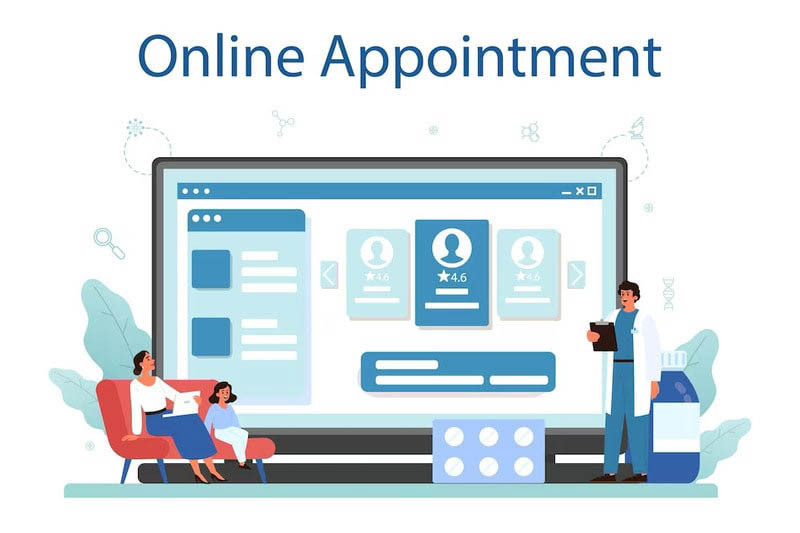
Online booking services with healthcare app development
Advanced Features for Healthcare Website Development
Social Login Option
Allowing users to sign up and join using their existing social media accounts (e.g., Facebook, Google, or Apple) eliminates the need for them to create a new account. This not only simplifies and expedites the registration process, but also streamlines it by reducing unnecessary steps.
Simple Search
To enhance user experience, an intuitive search bar should be implemented within the website. This search functionality empowers users to easily find specific medical professionals, services, treatments, or health-related information. The search results should provide accurate and helpful information to ensure users access the desired content effectively.
Chatbot Integration
A chatbot powered by artificial intelligence should be integrated. It can instantly answer common questions, help users find relevant information, and give basic medical advice. The chatbot must understand natural language and guide users effectively.
Online Booking Services
Patients have the convenience of booking appointments with doctors, specialists, and healthcare facilities using an online scheduling system. This system allows users to choose their desired dates, times, and services. Confirmation notifications are sent to both the users and the healthcare providers.
Online Payment System
Patients should have the ability to pay for medical services, appointments, prescriptions, and bills using a safe and easy-to-use online payment system. It’s vital to ensure all monetary transactions are encrypted, meeting all necessary data security standards.
Real-Time Analytics
Within the healthcare sector, it’s essential to evaluate a patient’s condition, keep an eye on how they’re responding to treatments and continually seek ways to enhance the standard of care provided. This kind of review helps doctors make educated decisions rooted in how successful a patient’s treatment plan is proving to be.
3D Virtual Tours
When individuals are in search of a hospital, it is common for them to assess the hospital’s exterior before making a visit. Now, one of the most effective methods to showcase the exceptional quality of a hospital is by offering 3D tours. These tours not only help in boosting sales but also captivate and engage potential customers, thereby grabbing their attention towards the hospital’s outstanding features.
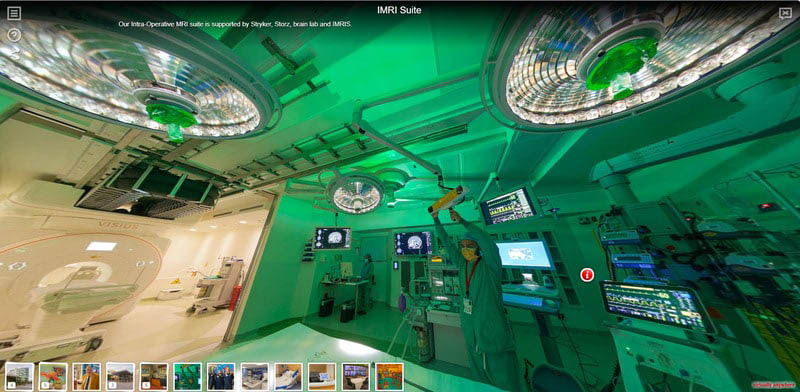
Healthcare facility virtual tours
Health Education
Common online health education platforms serve patients, physicians, and students who wish to advance their medical knowledge and credentials. These platforms provide users access to a wide variety of online materials, providing valuable resources that are readily available to help users find pertinent information whenever needed.
Gamification Elements
When creating a healthcare website app, we have the opportunity to transform the mundane treatment process into an engaging game, making it enjoyable for patients. For instance, encouraging children to take their medicine promptly and according to their doctor’s instructions can be turned into a playful activity. Upon completion, kids can receive rewards such as discount codes for their next appointment or free vitamins. This approach not only brings enjoyment but also fosters a sense of involvement in their healthcare journey.
Why do Companies Need Healthcare Web Application Development?
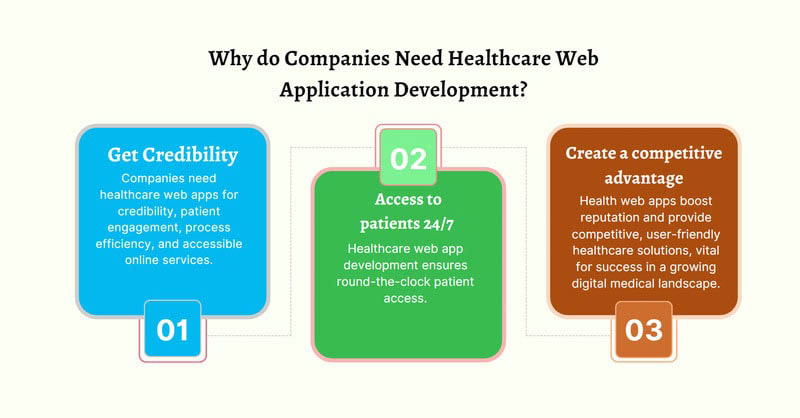
Get Credibility
In today’s digital era, a significant number of internet users around 47% search for information on doctors online. Moreover, around 63% of individuals rely on their online findings when choosing healthcare providers. Considering these statistics, it becomes crucial to establish a positive online presence. Developing a health web app can greatly contribute to building trust and a solid reputation among patients, positioning your healthcare center as a reliable source of information.
Access to patients 24/7
Anytime, day or night, individuals may find themselves in need of immediate medical attention. That’s where the health web app comes in. With its round-the-clock availability, clients can access the services they require without having to visit a hospital. From scheduling appointments to acquiring vital information or seeking assistance, everything can be done swiftly and effortlessly through this convenient platform.
Create a competitive advantage
To remain competitive in the medical field, healthcare providers must meet the wants of patients in a more cost-effective or superior manner compared to their rivals. One effective strategy to achieve this goal is by developing a web application that facilitates health monitoring. As previously mentioned, a robust online presence significantly influences patients’ decisions. Additionally, the healthcare sector is experiencing a substantial growth of 41.2% in investments, indicating its competitiveness and promising future.
By making health web apps, you improve your reputation and give people easy-to-use and competitive healthcare options in a digital world that is growing quickly.
What to Consider when Choosing Medical Website Development?
Before diving into the realm of medical web development, it is crucial to take into account various factors that can greatly influence overall success. Let’s explore some key aspects to consider:
Data Protection
- Robust data protection is crucial for medical web applications. It ensures that data leaks, security breaches, and cyber-attacks are prevented.
- Complying with regulations like HIPAA and HITECH is vital. These regulations ensure the protection of sensitive healthcare data.
- To protect patient data and maintain its privacy and security, healthcare organizations should implement strong security measures. These measures include end-to-end data encryption, multi-factor authentication, SSL, and AES-256 encryption.
UX/UI Design and Responsiveness
- The design of healthcare websites is crucial, with a focus on medical features and accuracy.
- User interfaces should be designed to facilitate efficient completion of urgent tasks, ensuring responsiveness across various devices and screen sizes.
Interoperability
- Interoperability between hardware and software must be seamless and secure for remote health data transmission.
- APIs facilitate data exchange between diverse wearable medical devices and application users.
Accessibility
- Adhere to W3C accessibility guidelines to prioritize accessibility for disabled users.
- Include resizable text, voice-activated readers, HTML elements, color contrast, and captions to ensure accessibility.
By addressing these factors before beginning healthcare web development, you can create a healthcare website application solution that is secure, interoperable, user-friendly, and accessible to a broad range of users, thereby contributing to the success and efficacy of your application.
How to Choose a Healthcare Web Development Team?
Outsourcing Agency
Pros
- Cost savings
Outsourcing is a more cost-effective option compared to forming an in-house development team. By outsourcing, you avoid the need to pay salaries, purchase equipment or infrastructure, and manage welfare programs. In return, you receive top-notch healthcare software.
- Expertise and experience
Software development companies possess a wealth of knowledge and experience in the healthcare industry. This enables them to ensure that your products meet all the industry regulations, standards, and requirements.
- Focus on core business operations
Outsourcing enables you to concentrate on the core business operations without developing health software.
- Time-saving
Software developers have human and technical resources available, helping deploy projects and shorten development times quickly.
- Easily Scalable
Outsourcing offers the flexibility to expand your project without the need to hire more staff. It allows you to meet increasing demands without the challenges of recruiting and training new employees. With outsourcing, scaling becomes easier and more efficient.
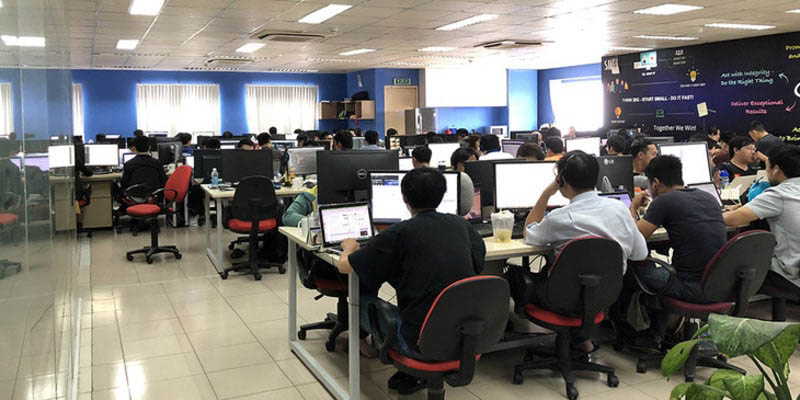
Nexle Corporation – Vietnamese healthcare web development company
Cons
Outsourcing health software development offers numerous benefits. It helps save costs and allows the main company to focus on its core operations. However, there are challenges to overcome. These include language barriers, cultural differences that hinder information sharing, and the complexities of managing projects across different time zones and locations. It’s important to be cautious of risks such as health information security and dependency on third parties.
However, you can be entirely certain by entrusting us with designing a healthcare web application.
Nexle Corporation stands as a prominent outsourcing business in Vietnam, specializing in healthcare web application development services. With a wealth of experience in the field, we prioritize maintaining utmost confidentiality and treating health and medical information. Our stringent security protocols guarantee constant protection of client data to the highest degree. We acknowledge the paramount importance of data security in the healthcare industry.
Freelancers
Pros
Hiring a freelancer for health app development saves money and offers project management flexibility. Freelancers work independently, adjusting to project needs, especially for small and uncomplicated projects.
Cons
On the other hand, if your goal is to create a multifaceted healthcare web app packed with advanced features and strictly abiding by medical rules. It’s wiser to hire a company known for its healthcare web app development expertise. Such an experienced company brings together a team of software development and data security professionals who will make certain your app ticks all boxes for quality and safety standards.
In the end, whether you choose to hire a freelancer or a healthcare app development company hinges on the demands of your project – its size, complexity, security needs, and quality standards.
In-house Team
Pros
In-house software teams offer control and direct communication, benefiting the project. Each team member contributes individually, ensuring commitment and success. Specialized healthcare-focused teams provide a deep understanding of industry regulations and requirements.
Cons
However, like any other organizational structure, a self-development team also has its drawbacks. One notable disadvantage is the financial aspect. Running an internal team entails substantial costs such as salaries, benefits, equipment, and ongoing training. Furthermore, recruiting and managing teams requires significant time and effort, and assembling a team with the necessary skills may not always be straightforward. Additionally, the team’s ability to adapt and embrace change may be limited, making it challenging to ensure they stay attuned to market and technology trends.
Conclusion
Creating a medical web application involves many important factors. From market competition and user-centered design to selecting the right technology and ensuring compliance, every aspect requires careful consideration.
A skilled team and technical expertise are essential when creating a successful medical web application. At Nexle Corporation, we have over ten years of experience in healthcare web development. With our industry knowledge and outsourcing expertise, we are ready to be your reliable partner in bringing your ideas to life. Contact us now to get started.


